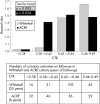Cardiothoracic ratio within the "normal" range independently predicts mortality in patients undergoing coronary angiography
- PMID: 17164481
- PMCID: PMC1861494
- DOI: 10.1136/hrt.2006.101238
Cardiothoracic ratio within the "normal" range independently predicts mortality in patients undergoing coronary angiography
Abstract
Objective: To determine whether cardiothoracic ratio (CTR), within the range conventionally considered normal, predicted prognosis in patients undergoing coronary angiography.
Design: Cohort study with a median of 7-years follow-up.
Setting: Consecutive patients undergoing coronary angiography at Barts and The London National Health Service (NHS) Trust.
Subjects: 1005 patients with CTRs measured by chest radiography, and who subsequently underwent coronary angiography. Of these patients, 7.3% had a CTR > or =0.5 and were excluded from the analyses.
Outcomes: All-cause mortality and coronary event (non-fatal myocardial infarction or coronary death). Adjustments were made for age, left ventricular dysfunction, ACE inhibitor treatment, body mass index, number of diseased coronary vessels and past coronary artery bypass graft.
Results: The risk of death was increased among patients with a CTR in the upper part of the normal range. In total, 94 (18.9%) of those with a CTR below the median of 0.42 died compared with 120 (27.8%) of those with a CTR between 0.42 and 0.49 (log rank test p<0.001). After adjusting for potential confounders, this increased risk remained (adjusted HR 1.45, 95% CI 1.03 to 2.05). CTR, at values below 0.5, was linearly related to the risk of coronary event (test for trend p = 0.024).
Conclusion: In patients undergoing coronary angiography, CTR between 0.42 and 0.49 was associated with higher mortality than in patients with smaller hearts. There was evidence of a continuous increase in risk with higher CTR. These findings, along with those in healthy populations, question the conventional textbook cut-off point of > or =0.5 being an abnormal CTR.
Conflict of interest statement
Conflict of interest: None.
References
-
- Panju A, Hemmelgarn B, Nishikawa J.et al A critical appraisal of the cardiovascular history and physical examination. In: Yusuf S, Cairns JA, Camm AJ, Fallen EL, Gersh BJ, eds. Evidence‐based cardiology. London: BMJ Books, 200314–22.
-
- Rubens M. The chest x‐ray in adult heart disease. In: Julian D, Camm AJ, Fox KM, Hall RJC, Poole‐Wilson PA, eds. Diseases of the heart. 2nd edn. London: Saunders, 1996253–283.
-
- Danzer C S. The cardiothoracic ratio. Am J Med Sci 1919157513–521.
Publication types
MeSH terms
LinkOut - more resources
Full Text Sources
Miscellaneous


